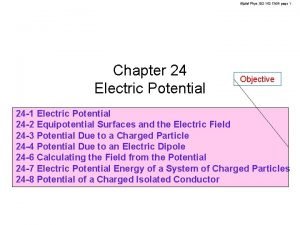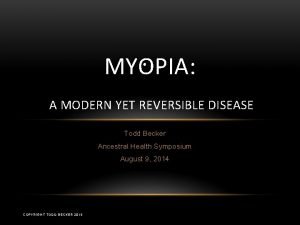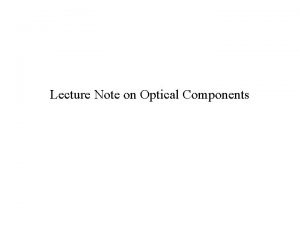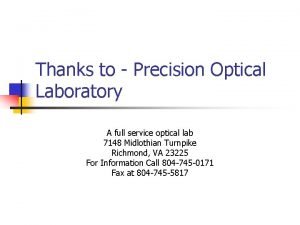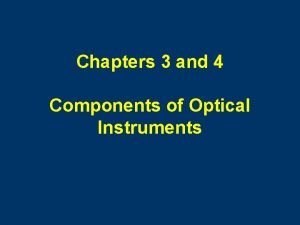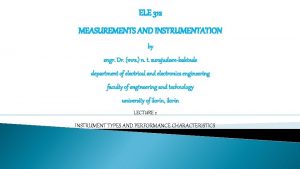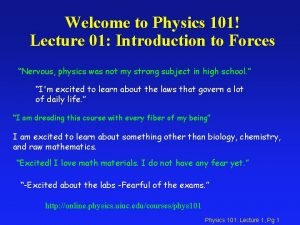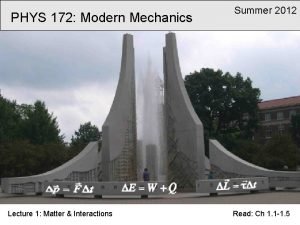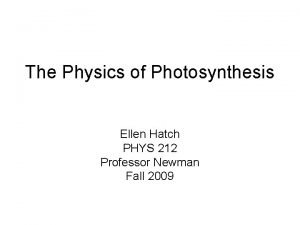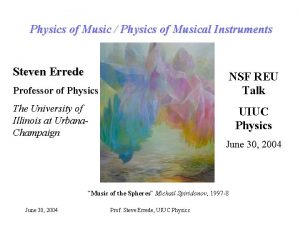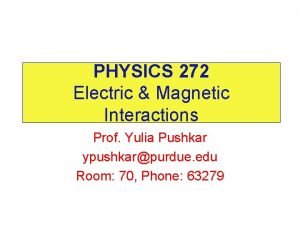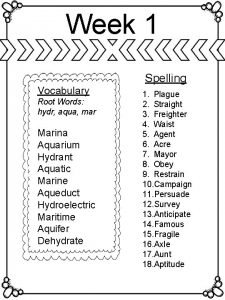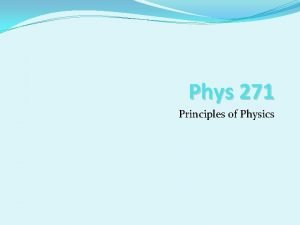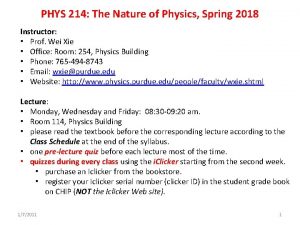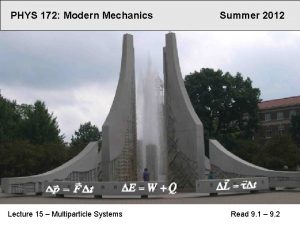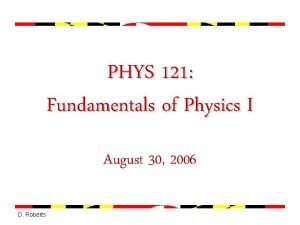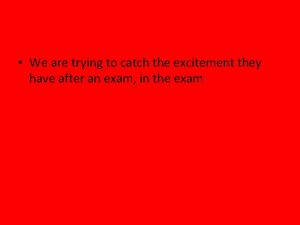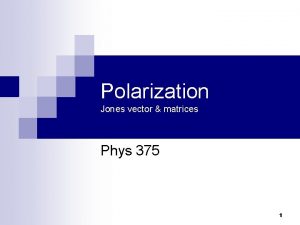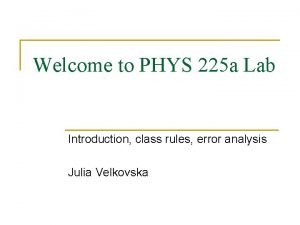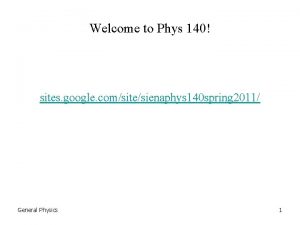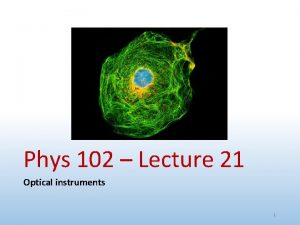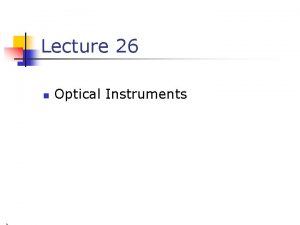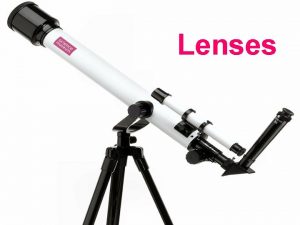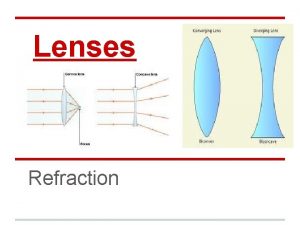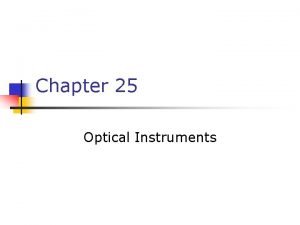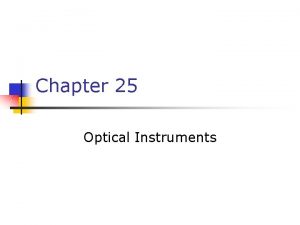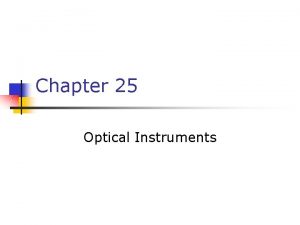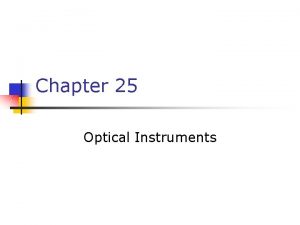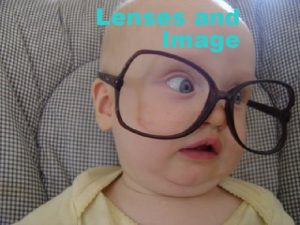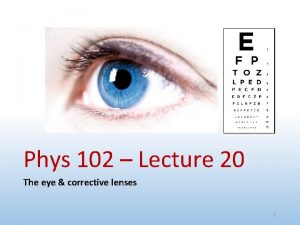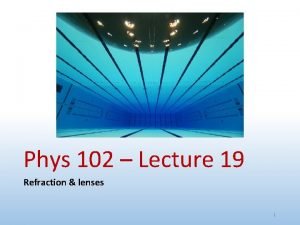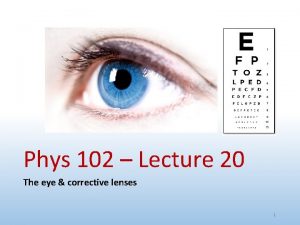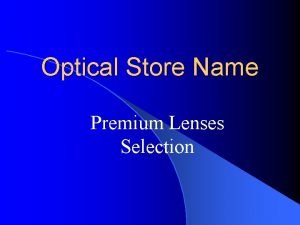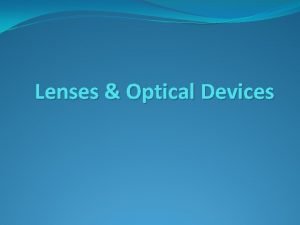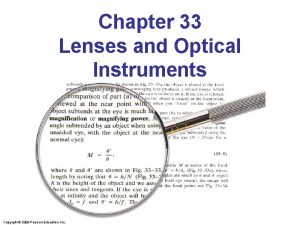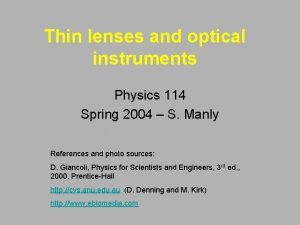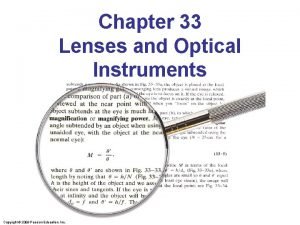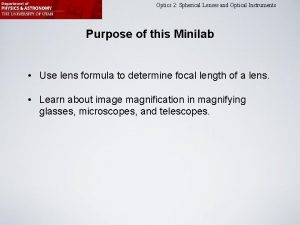Phys 102 Lecture 2324 Lenses and Optical Instruments
































- Slides: 32

Phys 102 Lecture 23/24 Lenses and Optical Instruments Key Points • Thin Lenses; Ray Tracing • Combinations of Lenses • The Human Eye; Corrective Lenses • Compound Microscope References 23 -7, 8, 9; 25 -2, 3, 4, 5.

Thin Lenses Thin lenses are those whose thickness is small compared to their radius of curvature. They may be either converging (a) or diverging (b).

Ray Tracing Parallel rays are brought to a focus by a converging lens (one that is thicker in the center than it is at the edge).

Ray Tracing A diverging lens (thicker at the edge than in the center) makes parallel light diverge; the focal point is that point where the diverging rays would converge if projected back.

The Power of a Lens The power of a lens is the inverse of its focal length: Lens power is measured in diopters, D: 1 D = 1 m-1.

Thin Lenses; Ray Tracing Ray tracing for thin lenses is similar to that for mirrors. We have three key rays: 1. This ray comes in parallel to the axis and exits through the focal point. 2. This ray comes in through the focal point and exits parallel to the axis. 3. This ray goes through the center of the lens and is undeflected.


For a diverging lens, we can use the same three rays. Ray 1 is drawn parallel to the axis, but does not pass through the focal point F’ behind the lens. Instead it seems to come from the focal point F in front of the lens.

Conceptual Example: Half-blocked lens. What happens to the image of an object if the top half of a lens is covered by a piece of cardboard? A) Half of the image is blocked, so we can only see half of the image. B) We can still see the whole image, but not as bright. C) The image is not affected at all.

The Thin Lens Equation The thin lens equation is similar to the mirror equation:

The sign conventions are slightly different: 1. The focal length is positive for converging lenses and negative for diverging. 2. The object distance is positive when the object is on the same side as the light entering the lens (not an issue except in compound systems); otherwise it is negative. 3. The image distance is positive if the image is on the opposite side from the light entering the lens; otherwise it is negative. 4. The height of the image is positive if the image is upright and negative otherwise.

The magnification formula is also the same as that for a mirror: The power of a lens (p=1/f) is positive if it is converging and negative if it is diverging.

Problem Solving: Thin Lenses 1. Draw a ray diagram. The image is located where the key rays intersect. 2. Solve for unknowns. 3. Follow the sign conventions. 4. Check that your answers are consistent with the ray diagram.

Example: Image formed by converging lens. What are (a) the position, and (b) the size, of the image of a 7. 6 -cmhigh leaf placed 1. 00 m from a +50. 0 -mm-focal-length camera lens?

Example: Object close to converging lens. An object is placed 10 cm from a 15 -cm-focal-length converging lens. Determine the image position and size (a) analytically, and (b) using a ray diagram.

Example: Diverging lens. Where must a small insect be placed if a 25 -cm-focal-length diverging lens is to form a virtual image 20 cm from the lens, on the same side as the object?

Combinations of Lenses In lens combinations, the image formed by the first lens becomes the object for the second lens (this is where object distances may be negative). The total magnification is the product of the magnification of each lens.

Example: A two-lens system. Two converging lenses, A and B, with focal lengths f. A = 20. 0 cm and f. B = 25. 0 cm, are placed 80. 0 cm apart. An object is placed 60. 0 cm in front of the first lens. Determine (a) the position, and (b) the magnification, of the final image formed by the combination of the two lenses.

Example: Measuring f for a diverging lens. To measure the focal length of a diverging lens, a converging lens is placed in contact with it. The Sun’s rays are focused by this combination at a point 28. 5 cm behind the lenses as shown. If the converging lens has a focal length f. C of 16. 0 cm, what is the focal length f. D of the diverging lens? Assume both lenses are thin and the space between them is negligible.

Cameras Basic parts of a camera: • Lens • Light-tight box • Shutter • Film or electronic sensor

The Human Eye The human eye resembles a camera in its basic functioning, with an adjustable lens, the iris, and the retina.

The Human Eye Near point: closest distance at which eye can focus clearly. Normal is about 25 cm. Far point: farthest distance at which object can be seen clearly. Normal is at infinity. Nearsightedness: far point is too close. Farsightedness: near point is too far away.

Corrective Lenses Nearsightedness can be corrected with a diverging lens.

Corrective Lenses And farsightedness with a converging lens.

Example: Farsighted eye. Sue is farsighted with a near point of 100 cm. Reading glasses must have what lens power so that she can read a newspaper at a distance of 25 cm? Assume the lens is very close to the eye.

Example: Nearsighted eye. A nearsighted eye has near and far points of 12 cm and 17 cm, respectively. (a) What lens power is needed for this person to see distant objects clearly, and (b) what then will be the near point? Assume that the lens is 2. 0 cm from the eye (typical for eyeglasses).

Magnifying Glass A magnifying glass (simple magnifier) is a converging lens. It allows us to focus on objects closer than the near point, so that they make a larger, and therefore clearer, image on the retina.

The power of a magnifying glass is described by its angular magnification: If the eye is relaxed (N is the near point distance and f the focal length): If the eye is focused at the near point:

Example: A jeweler’s “loupe. ” An 8 -cm-focal-length converging lens is used as a “jeweler’s loupe, ” which is a magnifying glass. Estimate (a) the magnification when the eye is relaxed, and (b) the magnification if the eye is focused at its near point N = 25 cm.

Compound Microscope A compound microscope also has an objective and an eyepiece; it is different from a telescope in that the object is placed very close to the eyepiece.

Compound Microscope The magnification is given by

Example: Microscope. A compound microscope consists of a 10 X eyepiece and a 50 X objective 17. 0 cm apart. Determine (a) the overall magnification, (b) the focal length of each lens, and (c) the position of the object when the final image is in focus with the eye relaxed. Assume a normal eye, so N = 25 cm.
 Uiuc phys 102
Uiuc phys 102 Aljalal phys 102
Aljalal phys 102 Aljalal phys 102
Aljalal phys 102 Charging by induction
Charging by induction Prevalence of astigmatism
Prevalence of astigmatism Optical amplifiers lecture notes
Optical amplifiers lecture notes Components of optical instruments
Components of optical instruments Precision optical blanks
Precision optical blanks Components of optical instruments
Components of optical instruments Active instruments and passive instruments
Active instruments and passive instruments Pressure measuring devices
Pressure measuring devices 01:640:244 lecture notes - lecture 15: plat, idah, farad
01:640:244 lecture notes - lecture 15: plat, idah, farad Phys 101 uiuc
Phys 101 uiuc Ucsd physics
Ucsd physics Calculating a percent difference
Calculating a percent difference Phys 172
Phys 172 Single slit envelope
Single slit envelope Http //www.phys.hawaii.edu/ teb/optics/java/slitdiffr/
Http //www.phys.hawaii.edu/ teb/optics/java/slitdiffr/ Phys 212 equation sheet
Phys 212 equation sheet Phys 398 uiuc
Phys 398 uiuc Si units for coulomb
Si units for coulomb In the term antipyretic the root pyret means
In the term antipyretic the root pyret means Plur root words
Plur root words Phys 271
Phys 271 Phys 214
Phys 214 Particl clicker
Particl clicker Phys 121 umd
Phys 121 umd Catch the excitement
Catch the excitement Phys 375
Phys 375 Physics 101 uiuc
Physics 101 uiuc Phys 225
Phys 225 Phys 140
Phys 140 Phys 244
Phys 244

